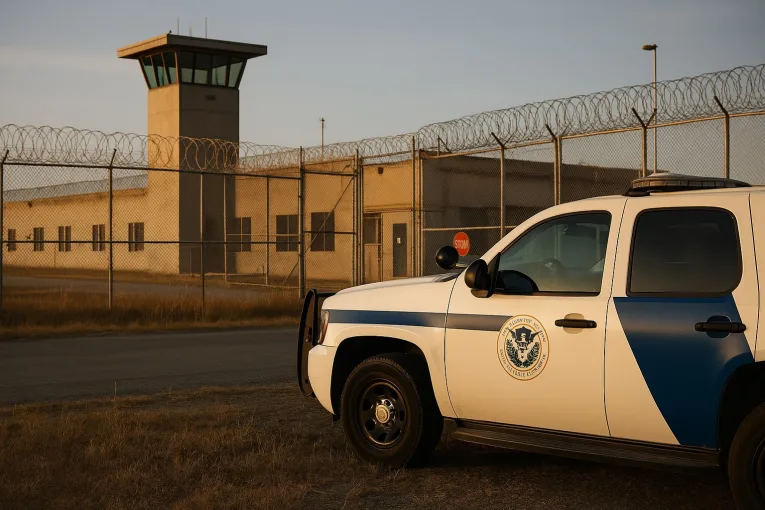
The state has already spent $300 million keeping shuttered prisons operational—as immigration raids escalate.
LOS ANGELES, CA – Advocates today warned that three recently closed California prisons are at risk of reopening as immigration detention centers under intensified federal immigration raids and arrests. The facilities—federal prison FCI Dublin, state-owned Chuckawalla Valley State Prison (CVSP), and privately run California City Correctional Facility—could soon be reactivated by Immigration and Customs Enforcement (ICE), placing migrants at risk and reversing California’s progress toward shrinking its carceral footprint.
ICE officials recently toured the shuttered FCI Dublin, a women’s prison closed after rampant sexual abuse scandals, assessing its reuse for immigrant detention, as reported by CBS Bay Area. GEO Group, the private prison company behind the California City Correctional Facility, similarly proposed the facility to ICE late last year, according to documents obtained by the ACLU.
“This is all deeply troubling,” said Brian Kaneda, Deputy Director of Californians United for a Responsible Budget (CURB), a coalition of more than 100 organizations calling for criminal justice reform. “FCI Dublin is a horrible place. It needs to be torn down or repurposed to better serve the community. State prisons that remain in costly ‘warm shutdown’ status must be permanently closed as well. Right now.”
CVSP closed last year but remains in a state-funded “warm shutdown”—minimally staffed, yet still fully functional. The cost of warm shutdowns to California taxpayers is staggering. Since Deuel Vocational Institution (DVI) closed in 2021, California has likely spent $146 million keeping the empty facility maintained. California Correctional Center (CCC), closed in 2023, has continued to cost taxpayers at least $87 million. Even after ending its contract for California City Correctional Facility in March 2024, the state spent another $81 million in just three months.
“This is what government waste actually looks like,” Kaneda emphasized. “Keeping empty prisons ready for ICE wastes critical funds that could go toward housing, education, or healthcare—especially at a time when federal threats to cut Medi-Cal funding loom.”
The state will save $900 million each year from prisons closed so far, and California’s Legislative Analyst’s Office (LAO) recommended closing five additional prisons, which would save taxpayers at least $1.5 billion annually. Some lawmakers cite Proposition 36, a ballot measure that increased penalties for certain crimes, to justify pausing prison closures. Yet state analyses—including the Governor’s budget and the Legislative Analyst’s Office—show only a temporary, modest population increase of approximately 1-4% before declining again due to implementation of existing reforms. “We can accomplish a lot if lawmakers and the administration forcefully oppose any kind of erosion of our state’s progress on criminal justice reform,” Kaneda said.
“California Model” Risks Normalizing Expanded Incarceration:
Advocates’ concerns come as Gov. Newsom promotes the “California Model,” a Nordic-inspired prison initiative emphasizing practices and outcomes often described as vague. CURB warns that investing in some of the model’s pillars could lead to expensive infrastructure projects that would erase the savings created by prison closure.
“We absolutely support culture change inside prisons and the investment in the programs led by incarcerated people. At the same time, it must be acknowledged that severe crises are plaguing California’s prisons that require immediate attention—including mental health emergencies, widespread abuses at women’s prisons, and growing heat, fire, and climate-related hazards,” said Kaneda. CURB advocates caution that California Model initiatives such as “dynamic security” will do little to address the actual issues at the root of prison violence.
“This is a very serious moment in history. At a time when forcibly disappearing someone off the street is becoming normalized, California shouldn’t focus on legitimizing new ways to sustain or expand prisons—even when framed as well-intentioned reforms like the California Model,” Kaneda continued. “Treating incarcerated people with dignity doesn’t require hundreds of millions in new infrastructure spending. We need tangible solutions to improve public safety outcomes for everyone—not a rebranding effort that makes us feel better about caging people.”
CURB urges Governor Newsom and the Legislature to take immediate action, including:
-
Fully end warm shutdowns: Permanently close empty prisons so they cannot reopen for ICE or any other incarceration use.
-
Legally prohibit or oppose reuse of closed facilities: Pass legislation explicitly preventing prisons from reopening as immigration detention centers or other carceral facilities. Oppose federal action to open any such facilities.
-
Repurpose prisons for community needs: Convert closed facilities into affordable housing, healthcare, and job training centers.
“It’s vital that people understand. The federal tactics targeting migrants today could easily be turned against someone you love tomorrow, even if they are a citizen,” said Kaneda. “This issue impacts everyone. These prisons must permanently close. Reinvest those savings into our communities and firmly resist every attempt—from ICE or elsewhere—to expand incarceration. Taking this stand now is essential to the safety of all of us, our economy, and our shared future.”